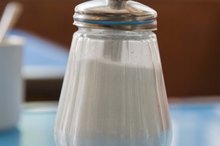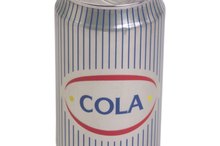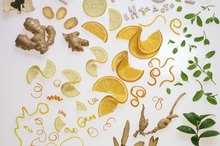What does fact checked mean?
At Healthfully, we strive to deliver objective content that is accurate and up-to-date. Our team periodically reviews articles in order to ensure content quality. The sources cited below consist of evidence from peer-reviewed journals, prominent medical organizations, academic associations, and government data.
- PubMed: Artificial Food Colouring and Hyperactivity Symptoms in Children
- PubMed: Artificial Food Colouring and Hyperactivity Symptoms in Children
- PubMed: Chronic Aspartame Affects T-Maze Performance, Brain Cholinergic Receptors and Na+,K+-ATPase in Rats
- PubMed: Chronic Aspartame Affects T-Maze Performance, Brain Cholinergic Receptors and Na+,K+-ATPase in Rats
The information contained on this site is for informational purposes only, and should not be used as a substitute for the advice of a professional health care provider. Please check with the appropriate physician regarding health questions and concerns. Although we strive to deliver accurate and up-to-date information, no guarantee to that effect is made.
Foods to Avoid on the Feingold Diet
Dr. Ben Feingold, a pediatrician and allergist working for Kaiser Permanente in San Francisco, noticed some of his patients with aspirin sensitivity also reacted to certain food additives. When these and natural sources of chemicals were eliminated, surprising behavior improvements occurred. Feingold started treating hyperactive children with an elimination diet, which came to be known as the Feingold diet. At first, about half of the children with attention deficit hyperactivity disorder in Feingold's care responded to dietary changes. Over time, the diet has evolved, and the Feingold Association claims a much higher success rate.
Artificial Colors, Flavorings and Preservatives
Petroleum-based synthetic food colorings, artificial flavors and preservatives, such as:
- BHA
- BHT
- TBHQ
- are not allowed on the Feingold diet
Other food additives that children may be sensitive to include MSG, sodium benzoate, nitrites and sulfites. Food labels can be misleading; the Feingold association publishes a food list and updates it monthly to help parents with shopping. A review of studies published in the October 2009 "Prescrire International" reports 15 double-blind clinical studies of children with ADHD showed increased hyperactivity associated with ingestion of food coloring. In addition, a placebo-controlled study of 297 children in the general population showed higher scores of hyperactive behavior after consumption of artificially colored drinks.
- Petroleum-based synthetic food colorings, artificial flavors and preservatives, such as: * BHA
* BHT
* TBHQ
* are not allowed on the Feingold diet Other food additives that children may be sensitive to include MSG, sodium benzoate, nitrites and sulfites. - A review of studies published in the October 2009 "Prescrire International" reports 15 double-blind clinical studies of children with ADHD showed increased hyperactivity associated with ingestion of food coloring.
Artificial Sweeteners
Can Diet Cause Anger in Kids?
Learn More
The widespread belief that sugar causes hyperactivity is not supported by data from Feingold's practice, but many sugary treats contain artificial colors. The Feingold diet allows sugar and stevia, but eliminates artificial sweeteners such as aspartame, sucralose, saccharine and neotame. B. Christian and colleagues at East Carolina University put aspartame in the drinking water of rats. After three to four months, the rats could not remember how to find a reward in a T-maze they had previously mastered. In this study, long-term aspartame consumption altered receptor cells and enzymes in the brain. The results were published in the May 2004 issue of "Pharmacology, Biochemistry and Behavior."
- The widespread belief that sugar causes hyperactivity is not supported by data from Feingold's practice, but many sugary treats contain artificial colors.
- B. Christian and colleagues at East Carolina University put aspartame in the drinking water of rats.
Foods that Contain Salicylates
Aspirin and food additives contain salicylates, which also occur naturally in fruits and vegetables. Salicylates may be elevated in produce that is picked early and shipped long distances and in concentrated foods such as tomato sauce, ketchup or fruit juices. Foods high in salicylates include:
- almonds
- apples
- apricots
- avocados
- berries
- broccoli
- cherries
- citrus fruits
- cloves
- coffee
- cucumbers
- dried fruits
- grapes
- kiwis
- nectarines
- olive oil
- peaches
- peppers
- pickles
- pineapple
- plums
- prunes
- raisins
- rose hips
- strawberries
- tea
- tomatoes
Sue Dengate, author of "Fed Up," reminds parents the effects of natural salicylates are dose-dependent 3. If food additives have been eliminated, the child may be able to enjoy a piece of fruit without triggering behavior problems. Healthy foods may be gradually added back into the diet while monitoring effects. Dengate states larger bodies react less to natural salicylates, therefore children often outgrow food intolerances.
- Aspirin and food additives contain salicylates, which also occur naturally in fruits and vegetables.
- Salicylates may be elevated in produce that is picked early and shipped long distances and in concentrated foods such as tomato sauce, ketchup or fruit juices.
Related Articles
References
- PubMed: Artificial Food Colouring and Hyperactivity Symptoms in Children
- PubMed: Chronic Aspartame Affects T-Maze Performance, Brain Cholinergic Receptors and Na+,K+-ATPase in Rats
- "Fed Up"; Sue Dengate; 2008
- Overview of Food Ingredients, Additives & Colors | FDA
- Lack of behavioral effects from Feingold diet violations - PubMed
- Effects of the Feingold diet on seizures and hyperactivity: a single-subject analysis - PubMed
- The Feingold diet: a current reappraisal - PubMed
- Hyperactivity and diet treatment: a meta-analysis of the Feingold hypothesis - PubMed
- The Feingold diet: an assessment of the reviews by Mattes, by Kavale and Forness and others - PubMed
- Artificial food dyes and attention deficit hyperactivity disorder - PubMed
- Diet and ADHD, Reviewing the Evidence: A Systematic Review of Meta-Analyses of Double-Blind Placebo-Controlled Trials Evaluating the Efficacy of Diet Interventions on the Behavior of Children with ADHD - PubMed
- Meta-Analysis of Attention-Deficit/Hyperactivity Disorder or Attention-Deficit/Hyperactivity Disorder Symptoms, Restriction Diet, and Synthetic Food Color Additives
- Dietary sensitivities and ADHD symptoms: thirty-five years of research - PubMed
- Diet and ADHD, Reviewing the Evidence: A Systematic Review of Meta-Analyses of Double-Blind Placebo-Controlled Trials Evaluating the Efficacy of Diet Interventions on the Behavior of Children with ADHD - PubMed
- Meta-Analysis of Attention-Deficit/Hyperactivity Disorder or Attention-Deficit/Hyperactivity Disorder Symptoms, Restriction Diet, and Synthetic Food Color Additives
- Artificial Food Colors and Attention-Deficit/Hyperactivity Symptoms: Conclusions to Dye for
- Artificial food dyes and attention deficit hyperactivity disorder - PubMed
- Diet and ADHD, Reviewing the Evidence: A Systematic Review of Meta-Analyses of Double-Blind Placebo-Controlled Trials Evaluating the Efficacy of Diet Interventions on the Behavior of Children with ADHD - PubMed
- Meta-Analysis of Attention-Deficit/Hyperactivity Disorder or Attention-Deficit/Hyperactivity Disorder Symptoms, Restriction Diet, and Synthetic Food Color Additives
- Artificial Food Colors and Attention-Deficit/Hyperactivity Symptoms: Conclusions to Dye for
- Overview of Food Ingredients, Additives & Colors | FDA
- Artificial food dyes and attention deficit hyperactivity disorder - PubMed
- Overview of Attention Deficit Hyperactivity Disorder in Young Children
- Attention Deficit Hyperactivity Disorder - StatPearls - NCBI Bookshelf
- Color Additives Questions and Answers for Consumers | FDA
- Diet and ADHD, Reviewing the Evidence: A Systematic Review of Meta-Analyses of Double-Blind Placebo-Controlled Trials Evaluating the Efficacy of Diet Interventions on the Behavior of Children with ADHD - PubMed
- Meta-Analysis of Attention-Deficit/Hyperactivity Disorder or Attention-Deficit/Hyperactivity Disorder Symptoms, Restriction Diet, and Synthetic Food Color Additives
- Dietary sensitivities and ADHD symptoms: thirty-five years of research - PubMed
- Effects of restriction on children’s intake differ by child temperament, food reinforcement, and parent’s chronic use of restriction
- Factors Influencing Children’s Eating Behaviours
- Impact of elimination diets on growth and nutritional status in children with multiple food allergies - PubMed
- Effects of restriction on children’s intake differ by child temperament, food reinforcement, and parent’s chronic use of restriction
- Factors Influencing Children’s Eating Behaviours
- Impact of elimination diets on growth and nutritional status in children with multiple food allergies - PubMed
- The psychosocial impact of food allergy and food hypersensitivity in children, adolescents and their families: a review - PubMed
- The psychosocial impact of food allergy and food hypersensitivity in children, adolescents and their families: a review - PubMed
- The relationship between sensory sensitivity, food fussiness and food preferences in children with neurodevelopmental disorders - PubMed
- Picky eating in children: causes and consequences
Writer Bio
Mary Earhart is a registered nurse, a public health nurse and licensed midwife. Her articles have appeared in professional journals and online ezines. She holds a Bachelor of Science in nursing from California State University at Dominguez Hills. She works in a family practice clinic, has a home birth practice and her specialty is perinatal substance abuse.









